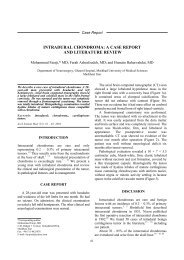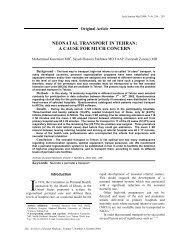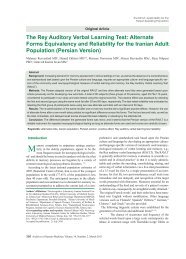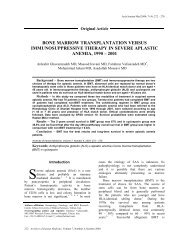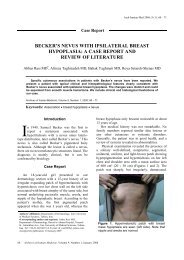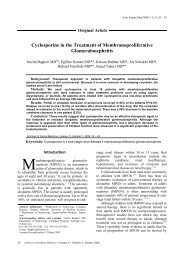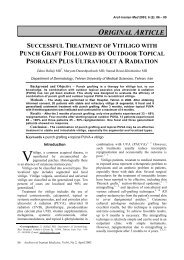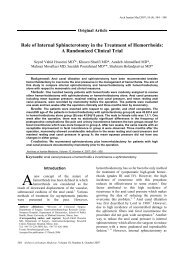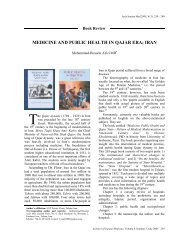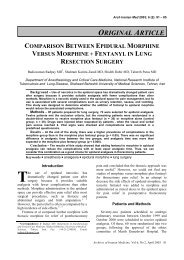P21 (Waf1/Cip1) gene polymorphisms and possible interaction with ...
P21 (Waf1/Cip1) gene polymorphisms and possible interaction with ...
P21 (Waf1/Cip1) gene polymorphisms and possible interaction with ...
You also want an ePaper? Increase the reach of your titles
YUMPU automatically turns print PDFs into web optimized ePapers that Google loves.
<strong>P21</strong> (<strong>Waf1</strong>/<strong>Cip1</strong>) <strong>gene</strong> <strong>polymorphisms</strong> <strong>and</strong> <strong>possible</strong> <strong>interaction</strong> <strong>with</strong> cigarette<br />
smoking in esophageal squamous cell carcinoma in northeastern Iran: A<br />
preliminary study<br />
Noushin Taghavi MD 1 , Firouzeh Biramijamal PhD 1 , Mohammad Reza Abbaszadegan PhD 2 ,<br />
Hooman Khademi MD MPH 3 , Masoud Sotoudeh MD 3 , Shahrouz Khoshbakht MSc 1 , Reza<br />
Malekzadeh MD AGAF 3<br />
1 National Institute of Genetic Engineering <strong>and</strong> Biotechnology (NIGEB), Tehran, Iran<br />
2<br />
Division of Human Genetics, Immunology Research Center, Bu-Ali Research<br />
Institute, Mashhad University of Medical Sciences, Mashhad, Iran<br />
3 Digestive Disease Research Center, Tehran University of Medical Sciences,<br />
Tehran, Iran<br />
Running title; <strong>P21</strong> (<strong>Waf1</strong>/<strong>Cip1</strong>) <strong>gene</strong> <strong>polymorphisms</strong> <strong>and</strong> <strong>possible</strong> <strong>interaction</strong> <strong>with</strong><br />
cigarette smoking in esophageal squamous cell carcinoma in northeastern Iran<br />
Noushin Taghavi<br />
taghavi.noushin@gmail.com<br />
Firouzeh Biramijamal<br />
f.birami@nigeb.ac.ir<br />
Mohammad Reza Abbaszadegan<br />
abbaszadeganmr@mums.ac.ir<br />
Hooman Khademi<br />
khademi@ams.ac.ir<br />
Masoud Sotoudeh<br />
sotoudeh@ams.ac.ir<br />
Shahrouz Khoshbakht<br />
Shahrouz14@gmail.com<br />
Reza Malekzadeh<br />
malek@ams.ac.ir<br />
All correspondence should be addressed to:<br />
1
Dr. Firouzeh Biramijamal, National Institute for Genetic of Engineering <strong>and</strong><br />
Biotechnology (NIGEB), Department of Medical Genetics, Shahrak-e Pajoohesh,<br />
17km, Tehran-Karaj High way, Tehran, Iran; P.O.Box: 14965/161<br />
Phone: +98-21- 445 80 382 ; Fax: +98-21- 445 80 399; f.birami@nigeb.ac.ir<br />
Abstract<br />
Background<br />
The incidence of Esophageal Squamous Cell Carcinoma [ESCC] is very high in<br />
northeastern Iran. However; the <strong>gene</strong>tic predisposing factors in this region have not<br />
been clearly defined. <strong>P21</strong> (waf1/cip1) <strong>gene</strong> involves in cellular growth arrest, induced by<br />
p53 tumor suppressor <strong>gene</strong>. Two <strong>polymorphisms</strong> of p21 <strong>gene</strong> in codon 31(p21<br />
C98A, dbSNP rs1801270) <strong>and</strong> the 3'UTR (p21 C70T, dbSNP rs1059234) may affect<br />
the protein expression <strong>and</strong> play a role in cancer susceptibility. The present study was<br />
aimed to investigate the association of p21 <strong>polymorphisms</strong> in codon 31 <strong>and</strong> the<br />
3'UTR, <strong>and</strong> cigarette smoking on the risk of ESCC in northeastern Iran.<br />
Methods<br />
A case-control study was carried out to detect the p21 polymorphism in the 3’UTR<br />
<strong>and</strong> codon 31 of samples from 126 ESCC cases <strong>and</strong> 100 controls from 2006 to<br />
2007. There were no significant difference of age <strong>and</strong> sex between cases <strong>and</strong><br />
controls. Genotyping of p21 <strong>polymorphisms</strong> were determined using PCR-RFLP<br />
method. Conditional logistic regression was used to adjust potential confounders.<br />
Results<br />
None of the p21 genotypes was significantly associated <strong>with</strong> risk of ESCC, even<br />
after adjusting for age <strong>and</strong> gender. (P=0.52, OR=1.24; 95% CI: 0.63-2.42) However,<br />
the presence of these <strong>polymorphisms</strong> <strong>and</strong> cigarette smoking had synergistic<br />
2
<strong>interaction</strong> in ESCC carcino<strong>gene</strong>sis in northeastern Iran. (P=0.02, OR=8.38; 95% CI:<br />
1.03-67.93)<br />
Conclusions<br />
Our data suggests: these two p21 <strong>polymorphisms</strong>, both alone <strong>and</strong> in combination,<br />
are not <strong>gene</strong>tic susceptibility biomarkers for ESCC. However their <strong>interaction</strong> <strong>with</strong><br />
cigarette smoking may influence the susceptibility to ESCC development in<br />
northeastern Iran.<br />
Key words: p21 polymorphism, Esophageal squamous cell carcinoma, cigarette<br />
smoking<br />
Introduction<br />
Esophageal cancer ranks as the sixth most common cause of cancer death<br />
worldwide. 1-2 The geographic distribution of incidence varies greatly due to<br />
environmental <strong>and</strong> <strong>gene</strong>tic factors. 3-5 Golestan Province is a part of the Turkmen<br />
plain in northeastern Iran, located at the western end of the “Esophageal Cancer<br />
Belt,” a region <strong>with</strong> very high rates of Esophageal Squamous Cell Carcinoma<br />
(ESCC). This region stretches from China westward through central Asia to northern<br />
Iran. 6-7 The incidence of esophageal cancer is very high in northern Iran (over 100<br />
cases per 10 5 person years, for both men <strong>and</strong> women), <strong>and</strong> ESCC is considered the<br />
predominant type. 8 However, the specific <strong>gene</strong>tic factors that predispose people in<br />
this region to this disease have not been clearly defined. 3, 8<br />
Various <strong>gene</strong>tic <strong>and</strong> environmental factors play important role in esophageal cancer<br />
development. 5, 9 Environmental factors such as cigarette smoking <strong>and</strong> heavy alcohol<br />
consumption, which account for many esophageal cancer cases in European <strong>and</strong><br />
North American countries, are not considered to be major risk factors in this region. 8,<br />
3
10-11 However, a recent study in Golestan province has shown a correlation between<br />
tobacco use <strong>and</strong> ESCC. 12<br />
Some studies have suggested that <strong>gene</strong>tic <strong>polymorphisms</strong> might explain individual<br />
differences in susceptibility to specific malignancies, including esophageal cancer. 13<br />
Several <strong>gene</strong>s involve in DNA repair <strong>and</strong> cell cycle control are associated <strong>with</strong><br />
esophageal carcino<strong>gene</strong>sis. 4 In response to DNA damage, wild-type p53, a tumor<br />
suppressor <strong>gene</strong>, assembles several downstream target <strong>gene</strong>s, including p21. <strong>P21</strong><br />
protein is a cell cycle regulator that induces G1 arrest, leading to DNA repair or<br />
apoptosis. 14-18<br />
Several studies have shown that p21 <strong>polymorphisms</strong> may affect the protein<br />
expression <strong>and</strong> activity <strong>and</strong> play a role in susceptibility to cancer. 19-20 Two major p21<br />
<strong>polymorphisms</strong>, in codon 31 (p21 C98A, dbSNP rs1801270) <strong>and</strong> in the 3’UTR (p21<br />
C70T, dbSNP rs1059234), both alone <strong>and</strong>/or in combination, may have an effect on<br />
carcino<strong>gene</strong>sis. 19 The p21C98A polymorphism results in a non-synonymous serine<br />
to arginine substitution in the protein, which affects the DNA-binding zinc finger motif.<br />
The other polymorphism, p21 C70T, occurs 20 nucleotide downstream of the stop<br />
codon, in the 3'-UTR. This region is considered to be an important site for cell<br />
differentiation, proliferation <strong>and</strong> tumor suppression. 21-23 Hence, it affects mRNA<br />
stability by inducing rapid message degradation, 24-27 leading to alteration in protein<br />
expression level.<br />
19, 28-30<br />
To our knowledge, no one has studied the effect of p21 <strong>gene</strong> <strong>polymorphisms</strong> on<br />
esophageal cancer risk in the high-risk area of northeastern Iran. To investigate the<br />
<strong>gene</strong>tic susceptibility of ESCC in this region, we conducted a preliminary study <strong>with</strong> a<br />
4
case-control design to pursue the association of cigarette smoking, opium use, p21<br />
<strong>polymorphisms</strong> in codon 31 <strong>and</strong> the 3'UTR, <strong>and</strong> ESCC.<br />
Materials & Methods<br />
Subjects<br />
Recruited subjects in this case-control study were selected from individuals referred<br />
to the Atrak clinic between May 2006 <strong>and</strong> December 2007. The Atrak clinic is<br />
considered as a referral center for upper GI disorders in Gonbad, the principle city in<br />
eastern Golestan. We estimate that approximately 95% of upper GI cancer patients<br />
in this region are referred to this clinic. 31 A total of 126 ESCC patients (108 female<br />
<strong>and</strong> 118 male; ages ranging from 32-89 years) who were diagnosed by upper GI<br />
endoscopy <strong>and</strong> confirmed histologically were considered as the case group. One<br />
hundred eligible controls included healthy volunteers that were r<strong>and</strong>omly selected<br />
from individuals visiting the Atrak clinic for upper GI health examination. They were<br />
diagnosed as healthy by physical examination <strong>and</strong> esophagoscopy followed by<br />
histology confirmation. The controls had no previous history of any cancer, were not<br />
being treated for any diseases, <strong>and</strong> were <strong>gene</strong>tically unrelated to the cases. There<br />
was no significant difference of age <strong>and</strong> sex between cases <strong>and</strong> controls. Both case<br />
<strong>and</strong> control groups included different ethnicities (Turkmen, Turk, Kurd <strong>and</strong> Fars) <strong>and</strong><br />
were restricted to people who had lived in Golestan province for at least ten years,<br />
meaning that they shared the same geographic origin <strong>and</strong> culture. Using a<br />
st<strong>and</strong>ardized questionnaire, trained interviewers collected demographic<br />
characteristics <strong>and</strong> information about cigarette smoking <strong>and</strong> opium use from both<br />
cases <strong>and</strong> control groups. After discharge, all subjects were regularly followed at the<br />
Atrak clinic every month for cases <strong>and</strong> every three months for the control group. All<br />
5
eligible patients <strong>and</strong> control individuals signed informed consent form according to<br />
institutional guidelines, <strong>and</strong> the study was approved by the research ethics<br />
committee of Tehran University of Medical Sciences.<br />
Specimens<br />
Tumor tissue was obtained from 126 histologically confirmed ESCC patients. Tumors<br />
were histologically verified as esophageal squamous cell carcinoma <strong>and</strong> sub-typed<br />
as well differentiated, moderately differentiated or poorly differentiated. We also<br />
performed the same assays using blood samples <strong>and</strong> normal adjacent tissue to<br />
optimize our results. Blood samples <strong>and</strong> normal esophageal tissue were also taken<br />
from 100 healthy controls. All tissue specimens were obtained by endoscope. The<br />
biopsies were fixed in 70% alcohol <strong>and</strong> processed in paraffin blocks for histological<br />
examination.<br />
Genotyping<br />
Genomic DNA was extracted from esophageal tumor <strong>and</strong> normal tissues <strong>with</strong> the<br />
QIAamp DNA mini kit (QIAGEN, Canada) <strong>and</strong> from whole blood cells <strong>with</strong> the Flexi<br />
Gene DNA kit (QIAGEN, Canada), according to the manufacturer’s instructions.<br />
a) PCR-RFLP for p21 codon 31<br />
The status of the p21 C98A polymorphism in codon 31 was determined by PCR-<br />
RFLP. We performed the PCR analysis according to the TaqPCR Core Kit (TaqPCR<br />
Core Kit, QIAGEN, Canada) manufacturer’s instruction. The PCR mixture contained<br />
10X concentrated Coralload PCR Buffer, which contains Tris-HCl, KCl, (NH4) 2 SO 4 ,<br />
15 mM MgCl 2 gel loading reagent, orange dye <strong>and</strong> red dye (pH 8.7), 5X<br />
concentrated Q-Solution Buffer, 10mM dNTP mix, RNase-free water, 1 pmol of each<br />
6
primer, 0.5 U of Taq DNA polymerase <strong>and</strong> template DNA. The amplification primers<br />
for the 272 bp region in exon 2 of the <strong>P21</strong> <strong>gene</strong> were: 5’-GTC AGA ACC GGC TGG<br />
GGA TG-3’ (forward) <strong>and</strong> 5’-CTC CTC CCA ACT CAT CCC GG-3’ (reverse). 32 The<br />
amplification conditions for codon 31 were initial denaturation at 95˚C for 5 min,<br />
followed by 35 cycles at 95°C for 30 seconds, 63.7°C for 30 seconds, 72°C for 40<br />
seconds, <strong>and</strong> a final 5 min extension step at 72°C. The 272 bp PCR-amplified<br />
fragment of p21 exon 2 was subsequently digested <strong>with</strong> the Bpu1102I restriction<br />
enzyme (Fermentas Co. Canada). Digestion of the wild-type allele (Ser) created<br />
DNA fragments of 89 <strong>and</strong> 183 bp whereas the Arg allele, which lacks a Bpu1102I<br />
site, yielded the original 272 bp fragment. The restriction-digested DNA was<br />
subjected to electrophoresis on a 2% agarose gel <strong>and</strong> stained <strong>with</strong> ethidium<br />
bromide. All genotypes were confirmed by direct sequencing at the start of<br />
genotyping (Fig. 1).<br />
b) PCR- RFLP for the 3'UTR of p21<br />
The PCR primers used for the amplification of a 298 bp region of the p21 genomic<br />
3’UTR were: 5’-CCCAGGGAAGGGTGTCCTG-3’ (forward) <strong>and</strong> 5’-<br />
GGGCGGCCAGGGTATGTAC-3’ (reverse). 30 Thermocycler parameters for this<br />
PCR were an initial cycle at 95°C for 5 min followed by 30 cycles at 95°C for 30<br />
seconds, 59°C for 30 seconds, 72°C for 30 seconds, <strong>and</strong> a final 5 min extension step<br />
at 72°C.The 298 bp fragment of p21 exon 3 was digested <strong>with</strong> the PstI restriction<br />
enzyme (Fermentas Co. Canada). PstI digestion of the wild-type allele, <strong>with</strong> one<br />
intact PstI site, leads to two DNA fragments of 126 <strong>and</strong> 173 bp. The C to T<br />
polymorphism causes the loss of the PstI site, resulting in one uncut DNA fragment<br />
of 298 bp. The restriction-digested DNA was subjected to electrophoresis on a 2%<br />
7
agarose gel <strong>and</strong> stained <strong>with</strong> ethidium bromide. Direct sequencing was performed to<br />
confirm the genotypes (Fig. 2).<br />
Statistical Analysis<br />
The distribution of demographic characteristics <strong>and</strong> substance use was examined<br />
using chi-square statistics <strong>and</strong> Fisher’s exact test for dichotomous variables <strong>and</strong><br />
Student’s t-test for continuous variables. Unconditional logistic regression model has<br />
been used for confounder effect adjustment. Genotypes were analyzed for Hardy-<br />
Weinberg equilibrium. Associations between ESCC <strong>and</strong> <strong>polymorphisms</strong> were<br />
evaluated by calculating the OR <strong>and</strong> 95% CI. To evaluate the presence of <strong>gene</strong>environment<br />
<strong>interaction</strong> we used ORs in multiplicative <strong>interaction</strong> model <strong>and</strong><br />
calculated the Synergy Index Multiplicative (SIM) as representative of presence of<br />
synergistic multiplicative <strong>interaction</strong> when SIM is more than 1. The Statistical<br />
Package for the Social Sciences software version 16.0 (SPSS Inc., Chicago, IL,<br />
USA) was used for statistical analyses. A two-sided P value < 0.05 was considered<br />
statistically significant.<br />
Results<br />
A total of 126 ESCC cases <strong>and</strong> 100 healthy controls were examined in this study.<br />
The mean age overall was 62.55±11 years, ranging from 32 to 89 years <strong>with</strong> a<br />
median of 62 years. The mean age of cases was 63.72±12 years <strong>with</strong> a median of<br />
64 years <strong>and</strong> the mean age of controls was 61.08±10 years <strong>with</strong> a median of 61<br />
years. There were no significant difference of age <strong>and</strong> gender between cases <strong>and</strong><br />
controls. One hundred <strong>and</strong> eighteen subjects (52.21%) were men <strong>and</strong> 108 (47.79%)<br />
were women. The distribution of demographic variables, smoking status <strong>and</strong> opium<br />
use for the cases <strong>and</strong> controls are summarized in Table 1.<br />
8
Codon 31 <strong>and</strong> 3’UTR <strong>polymorphisms</strong> of the p21 <strong>gene</strong> <strong>and</strong> ESCC risk:<br />
No deviation from Hardy-Weinberg Equilibrium was found for any of the observed<br />
loci for the p21 C98A polymorphism in codon 31 <strong>and</strong> the p21 C70T polymorphism.<br />
The frequencies of the wild type <strong>and</strong> variant genotypes for each of these SNPs were<br />
the same <strong>and</strong> equal to 78.57% for the wild type genotype <strong>and</strong> 21.43% for the variant<br />
genotype, respectively, among cases <strong>and</strong> 82% <strong>and</strong> 18%, respectively, among<br />
controls; after adjusting for some potential confounder variables including; smoking,<br />
opium use <strong>and</strong> ethnicity, this difference was not statistically significant (P= 0.52)<br />
(Table 2). No A/A or T/T genotypes were observed in either polymorphism.<br />
In addition, we analyzed the two <strong>polymorphisms</strong> of the p21 <strong>gene</strong> in combination.<br />
Four genotypic combinations emerged from the p21 C98A <strong>and</strong> p21 C70T<br />
<strong>polymorphisms</strong>. We then investigated the risk of ESCC for each group vs. all other<br />
genotypes. The frequency of “double-wild-type” genotype (C/C for both) was 98<br />
(77.78%) in cases <strong>and</strong> 82 (82%) in controls. The frequency of “C98A variant, C70T<br />
variant” genotype (C/A-C/T) in cases <strong>and</strong> controls was 28 (22.23%) <strong>and</strong> 18 (18%),<br />
respectively. There was neither “C98A wild-type, C70T variant” genotype (C/C-C/T)<br />
nor C70T wild-type, C98A variant” genotype (C/C-C/A) in either cases or controls.<br />
There were no statistically significant differences between combination groups.<br />
In addition, the data were subsequently stratified into subgroups based on smoking<br />
status, opium use <strong>and</strong> ethnicity. We evaluated the ESCC risk in each subgroup by<br />
estimating the ORs associated <strong>with</strong> the p21 C98A or C70T <strong>polymorphisms</strong>. There<br />
were no significant differences in any subgroups between individual genotypes or<br />
their combination.<br />
Interaction between cigarette smoking <strong>and</strong> C98A (C/A) or C70T (C/T)<br />
genotypes:<br />
9
A synergistic <strong>interaction</strong> between cigarette smoking <strong>and</strong> the p21 C98A polymorphism<br />
was observed in the recruited subjects (Table 3). Also, the p21 C70T polymorphism<br />
showed the same <strong>interaction</strong> <strong>with</strong> cigarette smoking. We also observed a complete<br />
linkage between two <strong>polymorphisms</strong> of p21, <strong>with</strong> a perfect LD of 1.0 (D-prime=1;<br />
P=0.000).<br />
Discussion<br />
This is the first study to investigate the effect of both <strong>polymorphisms</strong> of p21 <strong>gene</strong> in<br />
the codon 31 <strong>and</strong> in the 3’UTR on increased risk of ESCC in northeastern Iran,<br />
however we could not find any association between these two <strong>polymorphisms</strong> <strong>and</strong><br />
ESCC development. Furthermore, we have found cigarette smoking not only is<br />
considered as a risk factor for ESCC (P=0.03, OR=2.03; 95% CI: 1.03-4.00)<br />
, but also it interacts <strong>with</strong> p21 <strong>polymorphisms</strong> in susceptibility to ESCC (P=0.02,<br />
OR=8.38; 95% CI: 1.03-67.93).<br />
A previous study in Golestan province also showed that tobacco use was associated<br />
<strong>with</strong> a higher risk of developing ESCC (OR, 95% CI: 1.70, 1.05–2.73) 12 .<br />
Given that cigarette smoking increases the risk of ESCC, it is plausible that some<br />
mutagenic compounds, such as polycyclic aromatic hydrocarbons (PAH), which are<br />
10
important carcinogenic components of tobacco smoke, would influence the ESCC<br />
carcino<strong>gene</strong>sis in individuals <strong>with</strong> <strong>gene</strong>tic alterations 33 .<br />
On the other h<strong>and</strong>, different <strong>gene</strong>tic backgrounds not only may affect individuals’<br />
susceptibility to cancer, but may also modify the effects of environmental<br />
carcinogens. 34-41 It is <strong>possible</strong> that the variant forms of these two p21<br />
<strong>polymorphisms</strong> are associated <strong>with</strong> determinants of ESCC in response to certain<br />
environmental factors, including tobacco smoking. This polymorphism may<br />
consequently be a c<strong>and</strong>idate <strong>gene</strong>tic marker for screening ESCC risk in association<br />
<strong>with</strong> exposure to particular environmental carcinogens.<br />
Regarding the p21 C98A polymorphism, we observed that the frequency of the A<br />
allele was higher in ESCC cancer patients than the control group; however it was not<br />
statistically significant. This observation is consistent <strong>with</strong> the recent studies by Shih<br />
et al. <strong>and</strong> Lai et al. in Taiwanese <strong>and</strong> Su et al. in Caucasian population, in which no<br />
associations were detected between the polymorphism at codon 31 in the p21 <strong>gene</strong><br />
<strong>and</strong> the risk of developing several types of cancer. 42-44 However, other studies have<br />
actually reported an association of the Ser (C) allele <strong>with</strong> the risk of some specific<br />
types of cancer, including esophageal cancer. 28, 32, 45-48 This conflict in results might<br />
be attributed to one of several <strong>possible</strong> reasons, including non-r<strong>and</strong>om sampling,<br />
limited sample size, <strong>and</strong> different molecular mechanisms in carcino<strong>gene</strong>sis or ethnic<br />
disparity. The frequency of the Arg allele at codon 31 is significantly different<br />
between Caucasian (0.063–0.074) 19, 47 <strong>and</strong> Asian (0.408–0.571) populations.<br />
28, 32,<br />
44-45 Our results showed no allelic differences in the Arg allele of codon 31 between<br />
Turkmen <strong>and</strong> non-Turkmen ethnic groups, which is consistent <strong>with</strong> a recent study in<br />
this region that detected no significant differences between ethnic subgroups in the<br />
frequencies of several <strong>gene</strong>tic <strong>polymorphisms</strong> associated <strong>with</strong> esophageal cancer. 49<br />
11
Furthermore, another study suggested that ESCC risk was not much higher in<br />
Turkmen compared to non-Turkmen in Golestan province. 8 All of the findings from<br />
this region thus argue against the effect of ethnicity as a predominant ethological<br />
factor.<br />
Regarding the p21 C70T polymorphism, our results are in agreement <strong>with</strong> a report<br />
by Facher et al. that showed no significant association between this polymorphism<br />
<strong>and</strong> squamous cell carcinoma of Head <strong>and</strong> Neck 30 , though this association was<br />
indeed detected in a different study. 48 Our findings demonstrated despite a higher<br />
rate of polymorphic allele frequency (T allele) in ESCC cases, there was not a<br />
significant association between the p21 C70T polymorphism <strong>and</strong> ESCC risk.<br />
Conclusions<br />
This preliminary data suggests that (a) the p21 <strong>polymorphisms</strong> C98A <strong>and</strong> C70T were<br />
not associated <strong>with</strong> development of ESCC in northeastern Iran, <strong>and</strong> that (b) Geneenvironment<br />
<strong>interaction</strong> analysis showed that cigarette smoking may have<br />
synergistic <strong>interaction</strong>s <strong>with</strong> <strong>P21</strong> C/A <strong>and</strong> p21 C/T genotype in ESCC carcino<strong>gene</strong>sis<br />
in this region. Although we could not detect any association between p21 <strong>gene</strong><br />
<strong>polymorphisms</strong> in codon 31 or 3’UTR regions, we could not reject the modest effect<br />
of these <strong>polymorphisms</strong> on ESCC development in the studied population due to<br />
limited sample size in this study. Since this preliminary study is the first report on<br />
ESCC risk in northeastern Iran relative to p21 <strong>polymorphisms</strong>, further studies <strong>with</strong><br />
larger sample sizes <strong>and</strong> modified designs in diverse Iranian ethnic populations are<br />
needed to confirm our findings.<br />
12
Acknowledgments<br />
This research is supported by the Digestive Diseases Research Center (DDRC) of<br />
Tehran University of medical sciences. The contribution of this organization’s<br />
scientific collaborators is greatly acknowledged: Dr. Saeed Esmaili, Dr. Dariush<br />
Nasrollahzadeh, Dr. Ramin Shakeri, Dr. Karim Aghcheli, Ms. Safora Kor, Mrs Bita<br />
13
Mohammadi, Mr. Ali Mohammadi, Ms. Seyedeh Parisima Azizmi <strong>and</strong> Mr. Ashor<br />
Yolmeh.<br />
References<br />
1. Parkin DM, Bray F, Ferlay J, Pisani P. Global cancer statistics, 2002. CA Cancer J Clin<br />
2005;55:74‐108.<br />
2. Kamangar F, Dores GM, Anderson WF. Patterns of cancer incidence, mortality, <strong>and</strong><br />
prevalence across five continents: defining priorities to reduce cancer disparities in different<br />
geographic regions of the world. J Clin Oncol 2006;24:2137‐50.<br />
14
3. Ke L. Mortality <strong>and</strong> incidence trends from esophagus cancer in selected geographic areas<br />
of China circa 1970‐90. Int J Cancer 2002;102:271‐4.<br />
4. Hiyama T, Yoshihara M, Tanaka S, Chayama K. Genetic <strong>polymorphisms</strong> <strong>and</strong> esophageal<br />
cancer risk. Int J Cancer 2007;121:1643‐58.<br />
5. Hiyama T, Tanaka S, Shima H, Kose K, Kitadai Y, Ito M, Sumii M, Yoshihara M, Shimamoto<br />
F, Haruma K, Chayama K. Somatic mutation of mitochondrial DNA in Helicobacter pylori‐associated<br />
chronic gastritis in patients <strong>with</strong> <strong>and</strong> <strong>with</strong>out gastric cancer. Int J Mol Med 2003;12:169‐74.<br />
6. Kmet J, Mahboubi E. Esophageal cancer in the Caspian littoral of Iran: initial studies.<br />
Science 1972;175:846‐53.<br />
7. Mahboubi E, Kmet J, Cook PJ, Day NE, Ghadirian P, Salmasizadeh S. Oesophageal cancer<br />
studies in the Caspian Littoral of Iran: the Caspian cancer registry. Br J Cancer 1973;28:197‐214.<br />
8. Islami F, Kamangar F, Aghcheli K, Fahimi S, Semnani S, Taghavi N, Marjani HA, Merat S,<br />
Nasseri‐Moghaddam S, Pourshams A, Nouraie M, Khatibian M, et al. Epidemiologic features of upper<br />
gastrointestinal tract cancers in Northeastern Iran. Br J Cancer 2004;90:1402‐6.<br />
9. Hiyama T, Haruma K, Kitadai Y, Masuda H, Miyamoto M, Tanaka S, Yoshihara M,<br />
Shimamoto F, Chayama K. K‐ras mutation in helicobacter pylori‐associated chronic gastritis in<br />
patients <strong>with</strong> <strong>and</strong> <strong>with</strong>out gastric cancer. Int J Cancer 2002;97:562‐6.<br />
10. Munoz N, Buiatti E. Chemoprevention of oesophageal cancer. IARC Sci Publ 1996:27‐33.<br />
11. Brown LM HR, Silverman D, Baris D, Hayes R, Swanson GM, Schoenberg J, Greenberg R,<br />
Liff J, Schwartz A, Dosemeci M, Pottern L, Fraumeni Jr JF. Excess incidence of squamous cell<br />
esophageal cancer among US Black men: role of social class <strong>and</strong> other risk factors. Am J Epidemiol<br />
2001;153:114 –22.<br />
12. Nasrollahzadeh D, Kamangar F, Aghcheli K, Sotoudeh M, Islami F, Abnet CC, Shakeri R,<br />
Pourshams A, Marjani HA, Nouraie M, Khatibian M, Semnani S, et al. Opium, tobacco, <strong>and</strong> alcohol<br />
use in relation to oesophageal squamous cell carcinoma in a high‐risk area of Iran. Br J Cancer<br />
2008;98:1857‐63.<br />
13. Xing D, Tan W, Lin D. Genetic <strong>polymorphisms</strong> <strong>and</strong> susceptibility to esophageal cancer<br />
among Chinese population (review). Oncol Rep 2003;10:1615‐23.<br />
14. el‐Deiry WS, Harper JW, O'Connor PM, Velculescu VE, Canman CE, Jackman J, Pietenpol<br />
JA, Burrell M, Hill DE, Wang Y. WAF1/CIP1 is induced in p53‐mediated G1 arrest <strong>and</strong> apoptosis.<br />
Cancer Res 1994;54:1169‐74.<br />
15. Harper JW, Adami,G.R., Wei,N., Keyomarsi,K. <strong>and</strong> Elledge,S.J. The p21 Cdk‐interacting<br />
protein <strong>Cip1</strong> is a potent inhibitor of G1 cyclindependent kinases. Cell 1993;75:805‐‐16.<br />
16. Xiong Y, Hannon GJ, Zhang H, Casso D, Kobayashi R, Beach D. p21 is a universal inhibitor<br />
of cyclin kinases. Nature 1993;366:701‐4.<br />
17. Parker SB, Eichele G, Zhang P, Rawls A, S<strong>and</strong>s AT, Bradley A, Olson EN, Harper JW, Elledge<br />
SJ. p53‐independent expression of p21<strong>Cip1</strong> in muscle <strong>and</strong> other terminally differentiating cells.<br />
Science 1995;267:1024‐7.<br />
18. Zhang H, Xiong Y, Beach D. Proliferating cell nuclear antigen <strong>and</strong> p21 are components of<br />
multiple cell cycle kinase complexes. Mol Biol Cell 1993;4:897‐906.<br />
19. Li G, Liu Z, Sturgis EM, Shi Q, Chamberlain RM, Spitz MR, Wei Q. Genetic <strong>polymorphisms</strong><br />
of p21 are associated <strong>with</strong> risk of squamous cell carcinoma of the head <strong>and</strong> neck. Carcino<strong>gene</strong>sis<br />
2005;26:1596‐602.<br />
20. Roninson IB. Oncogenic functions of tumour suppressor p21(<strong>Waf1</strong>/<strong>Cip1</strong>/Sdi1):<br />
association <strong>with</strong> cell senescence <strong>and</strong> tumourpromoting activities of stromal fibroblasts. Cancer Lett<br />
2002;179:1‐‐14.<br />
21. Rastinejad F BH. Genetic complementation reveals a novel regulatory role for 3*<br />
untranslated regions in growth <strong>and</strong> differentiation. Cell 1993;72:903–17.<br />
22. Rastinejad F CM, R<strong>and</strong>o TA, Blau HM. Tumor suppression by RNA from the 3*<br />
untranslated region of a‐Tropomyosin. Cell 1993;75:1107–17.<br />
15
23. Fan H VC, Huang A, Wright JA. Suppression of malignancy by the 3* untranslated regions<br />
of ribonucleotide reductase R1 <strong>and</strong> R2 messenger RNAs. Cancer Res 1996;56:4366–9.<br />
24. Chen FY AF, Wright JA. Mammalian ribonucleotide reductase R1 mRNA stability under<br />
normal <strong>and</strong> phorbol ester stimulating conditions: involvement of a cis‐trans <strong>interaction</strong> at the 3*<br />
untranslated region. EMBO J 1993;12:3977–86.<br />
25. Amara FM, Chen FY, Wright JA. Phorbol ester modulation of a novel cytoplasmic protein<br />
binding activity at the 3'‐untranslated region of mammalian ribonucleotide reductase R2 mRNA <strong>and</strong><br />
role in message stability. J Biol Chem 1994;269:6709‐15.<br />
26. Amara FM HR, Huang A, Wright JA. Altered regulation of message stability <strong>and</strong> tumor<br />
promoter‐responsive cis‐trans <strong>interaction</strong> of ribonucleotide reductase R1 <strong>and</strong> R2 messenger RNAs in<br />
hydroxyurea‐resistant cells. Cancer Res 1995;55:4503–6.<br />
27. Amara FM CF, Wright JA. Defining a novel cis element in the 3*‐untranslated region of<br />
mammalian ribonucleotide reductase component R2 mRNA: role in transforming growth factor‐b1<br />
induced mRNA stabilization. Nucleic Acids Res 1995;23:1461–7.<br />
28. Wu MT, Wu DC, Hsu HK, Kao EL, Yang CH, Lee JM. Association between p21 codon 31<br />
polymorphism <strong>and</strong> esophageal cancer risk in a Taiwanese population. Cancer Lett 2003;201:175‐80.<br />
29. Mousses S, Ozcelik H, Lee PD, Malkin D, Bull SB, Andrulis IL. Two variants of the<br />
CIP1/WAF1 <strong>gene</strong> occur together <strong>and</strong> are associated <strong>with</strong> human cancer. Hum Mol Genet<br />
1995;4:1089‐92.<br />
30. Facher EA, Becich MJ, Deka A, Law JC. Association between human cancer <strong>and</strong> two<br />
<strong>polymorphisms</strong> occurring together in the p21(<strong>Waf1</strong>/<strong>Cip1</strong>) cyclin‐dependent kinase inhibitor <strong>gene</strong>.<br />
Cancer 1997;79:2424‐9.<br />
31. Taghavi N, Nasrollahzadeh D, Merat S, Yazdanbod A, Hormazdi M, Sotoudeh M, Semnani<br />
S, Eslami F, Marjani HA, Fahimi S, Khademi H, Malekzadeh R. Epidemiology of upper gastrointestinal<br />
cancers in Iran: a sub site analysis of 761 cases. World J Gastroenterol 2007;13:5367‐70.<br />
32. Huang SP, Wu WJ, Chang WS, Wu MT, Chen YY, Chen YJ, Yu CC, Wu TT, Lee YH, Huang JK,<br />
Huang CH. p53 Codon 72 <strong>and</strong> p21 codon 31 <strong>polymorphisms</strong> in prostate cancer. Cancer Epidemiol<br />
Biomarkers Prev 2004;13:2217‐24.<br />
33. Quinones LA, Irarrazabal CE, Rojas CR, Orellana CE, Acevedo C, Huidobro C, Varela NE,<br />
Caceres DD. Joint effect among p53, CYP1A1, GSTM1 polymorphism combinations <strong>and</strong> smoking on<br />
prostate cancer risk: an exploratory genotype‐environment <strong>interaction</strong> study. Asian J Androl<br />
2006;8:349‐55.<br />
34. Tan W, Song N, Wang GQ, Liu Q, Tang HJ, Kadlubar FF, Lin DX. Impact of <strong>gene</strong>tic<br />
<strong>polymorphisms</strong> in cytochrome P450 2E1 <strong>and</strong> glutathione S‐transferases M1, T1, <strong>and</strong> P1 on<br />
susceptibility to esophageal cancer among high‐risk individuals in China. Cancer Epidemiol<br />
Biomarkers Prev 2000;9:551‐6.<br />
35. van Lieshout EM, Roelofs HM, Dekker S, Mulder CJ, Wobbes T, Jansen JB, Peters WH.<br />
Polymorphic expression of the glutathione S‐transferase P1 <strong>gene</strong> <strong>and</strong> its susceptibility to Barrett's<br />
esophagus <strong>and</strong> esophageal carcinoma. Cancer Res 1999;59:586‐9.<br />
36. Roth MJ, Dawsey SM, Wang G, Tangrea JA, Zhou B, Ratnasinghe D, Woodson KG, Olivero<br />
OA, Poirier MC, Frye BL, Taylor PR, Weston A. Association between GSTM1*0 <strong>and</strong> squamous<br />
dysplasia of the esophagus in the high risk region of Linxian, China. Cancer Lett 2000;156:73‐81.<br />
37. Morita S, Yano M, Tsujinaka T, Akiyama Y, Taniguchi M, Kaneko K, Miki H, Fujii T, Yoshino<br />
K, Kusuoka H, Monden M. Genetic <strong>polymorphisms</strong> of drug‐metabolizing enzymes <strong>and</strong> susceptibility<br />
to head‐<strong>and</strong>‐neck squamous‐cell carcinoma. Int J Cancer 1999;80:685‐8.<br />
38. Butler WJ, Ryan P, Roberts‐Thomson IC. Metabolic genotypes <strong>and</strong> risk for colorectal<br />
cancer. J Gastroenterol Hepatol 2001;16:631‐5.<br />
39. Rojas M, Cascorbi I, Alex<strong>and</strong>rov K, Kriek E, Auburtin G, Mayer L, Kopp‐Schneider A, Roots<br />
I, Bartsch H. Modulation of benzo[a]pyrene diolepoxide‐DNA adduct levels in human white blood<br />
cells by CYP1A1, GSTM1 <strong>and</strong> GSTT1 polymorphism. Carcino<strong>gene</strong>sis 2000;21:35‐41.<br />
16
40. Tanimoto K, Hayashi S, Yoshiga K, Ichikawa T. Polymorphisms of the CYP1A1 <strong>and</strong> GSTM1<br />
<strong>gene</strong> involved in oral squamous cell carcinoma in association <strong>with</strong> a cigarette dose. Oral Oncol<br />
1999;35:191‐6.<br />
41. Sato M, Sato T, Izumo T, Amagasa T. Genetic polymorphism of drug‐metabolizing<br />
enzymes <strong>and</strong> susceptibility to oral cancer. Carcino<strong>gene</strong>sis 1999;20:1927‐31.<br />
42. Shih CM, Lin PT, Wang HC, Huang WC, Wang YC. Lack of evidence of association of<br />
p21WAF1/CIP1 polymorphism <strong>with</strong> lung cancer susceptibility <strong>and</strong> prognosis in Taiwan. Jpn J Cancer<br />
Res 2000;91:9‐15.<br />
43. Su L, Liu G, Zhou W, Xu LL, Miller DP, Park S, Lynch TJ, Wain JC, Christiani DC. No<br />
association between the p21 codon 31 serine‐arginine polymorphism <strong>and</strong> lung cancer risk. Cancer<br />
Epidemiol Biomarkers Prev 2003;12:174‐5.<br />
44. Lai KC, Chen WC, Jeng LB, Li SY, Chou MC, Tsai FJ. Association of <strong>gene</strong>tic <strong>polymorphisms</strong><br />
of MK, IL‐4, p16, p21, p53 <strong>gene</strong>s <strong>and</strong> human gastric cancer in Taiwan. Eur J Surg Oncol 2005;31:1135‐<br />
40.<br />
45. Roh J, Kim M, Kim J, Park N, Song Y, Kang S, Lee H. Polymorphisms in codon 31 of p21<br />
<strong>and</strong> cervical cancer susceptibility in Korean women. Cancer Lett 2001;165:59‐62.<br />
46. Roh JW, Kim JW, Park NH, Song YS, Park IA, Park SY, Kang SB, Lee HP. p53 <strong>and</strong> p21<br />
<strong>gene</strong>tic <strong>polymorphisms</strong> <strong>and</strong> susceptibility to endometrial cancer. Gynecol Oncol 2004;93:499‐505.<br />
47. Pop<strong>and</strong>a O, Edler L, Waas P, Schattenberg T, Butkiewicz D, Muley T, Dienemann H, Risch<br />
A, Bartsch H, Schmezer P. Elevated risk of squamous‐cell carcinoma of the lung in heavy smokers<br />
carrying the variant alleles of the TP53 Arg72Pro <strong>and</strong> p21 Ser31Arg <strong>polymorphisms</strong>. Lung Cancer<br />
2007;55:25‐34.<br />
48. Kibel AS, Suarez BK, Belani J, Oh J, Webster R, Brophy‐Ebbers M, Guo C, Catalona WJ,<br />
Picus J, Goodfellow PJ. CDKN1A <strong>and</strong> CDKN1B <strong>polymorphisms</strong> <strong>and</strong> risk of advanced prostate<br />
carcinoma. Cancer Res 2003;63:2033‐6.<br />
49. Sepehr A, Kamangar F, Abnet CC, Fahimi S, Pourshams A, Poustchi H, Zeinali S, Sotoudeh<br />
M, Islami F, Nasrollahzadeh D, Malekzadeh R, Taylor PR, et al. Genetic <strong>polymorphisms</strong> in three<br />
Iranian populations <strong>with</strong> different risks of esophageal cancer, an ecologic comparison. Cancer Lett<br />
2004;213:195‐202.<br />
Tables<br />
Factor<br />
Case<br />
n=126<br />
Control<br />
n= 100<br />
Age (year)<br />
Yes 33 (26.6%) 15 (15.2%) 4.28 0.03<br />
No 91 (73.4%) 84 (84.8%)<br />
Opium Use<br />
Yes 45 (36.3%) 24 (24.2%) 3.74 0.05<br />
No 79 (63.7%) 75 (75.8%)<br />
Ethnicity<br />
Turkmen 64 (51.6%) 48 (52.7%) 0.02 0.86<br />
Non‐<br />
Turkmen<br />
60 (48.4%) 43 (47.3%)<br />
a The differences between cases <strong>and</strong> controls were evaluated by two‐sided chi square<br />
for discontinuous variables.<br />
* There were no data available for some study subjects for some variables.<br />
Table 1 comparability of age, gender, Cigarette smoking, opium use <strong>and</strong> ethnicity<br />
in cases <strong>and</strong> controls*.<br />
18
Case<br />
[n (%)]<br />
Control<br />
[n (%)]<br />
Total<br />
<strong>P21</strong> C98A polymorphism<br />
C/C<br />
99<br />
(78.6%)<br />
82<br />
(82%)<br />
C/A<br />
27<br />
(21.4%)<br />
18<br />
(18%)<br />
A allele<br />
frequency<br />
Adjusted a<br />
OR<br />
(95% CI)<br />
C/C<br />
0.107<br />
99<br />
1.24 (78.6%)<br />
0.09 (0.63‐2.41) 82<br />
(82%)<br />
<strong>P21</strong> C70Tpolymorphism<br />
C/T<br />
27<br />
(21.4%)<br />
18<br />
(18%)<br />
181 45 181 45<br />
a we adjusted the OR for covariates (ethnicity, smoking, <strong>and</strong> opium use).<br />
T allele<br />
frequenc<br />
y<br />
0.107<br />
0.09<br />
Adjusted a<br />
OR<br />
(95%CI)<br />
1.24<br />
(0.63‐2.41)<br />
Table 2 <strong>P21</strong> genotype <strong>and</strong> allele frequencies of cases <strong>and</strong> controls <strong>and</strong> their<br />
association <strong>with</strong> risk of ESCC<br />
Smoking <strong>P21</strong>C98A Case Control OR OR95%CI χ 2 P<br />
No No 73 68 1.00 ‐ ‐ ‐<br />
Yes No 24 14 1.6 0.76‐3.34 1.56 0.21<br />
No Yes 18 16 1.05 0.49‐2.22 0.01 0.90<br />
Yes Yes 9 1 8.38 1.03‐67.93 5.50 0.02<br />
SIM=8.38/(1.6× 1.05) = 4.99<br />
Table 3 Interaction of smoking <strong>and</strong> p21 C98A genotype<br />
19
Figure 1 - PCR assay <strong>and</strong> direct-sequencing to detect <strong>gene</strong>tic polymorphism at p21<br />
codon 31 (C98A). A. p21 codon 31 polymorphism, AGC-to-AGA change which<br />
resulted in an amino acid substitution from serine (AGC) to arginine (AGA). The Ser<br />
alleles <strong>with</strong> BPU1102I site <strong>gene</strong>rated two 89-bp <strong>and</strong> 183-bp fragments. A<br />
heterozygous form of AGC/AGA yielded three fragments (272, 183 <strong>and</strong> 89 bp). B.<br />
p21 codon 31 polymorphism was confirmed by direct sequencing.<br />
20
Figure 2 - The PCR-RFLP analyses <strong>and</strong> direct sequence result of p21 C70T in<br />
3’UTR. A. The genotype of p21 C70T was identified by a C allele <strong>with</strong> fragment<br />
length of 173 <strong>and</strong> 125 bp <strong>and</strong> a heterozygous form of C/T yielded three fragments<br />
(298, 173 <strong>and</strong> 125 bp). B. p21 C70T polymorphism was confirmed by direct<br />
sequencing.<br />
21



